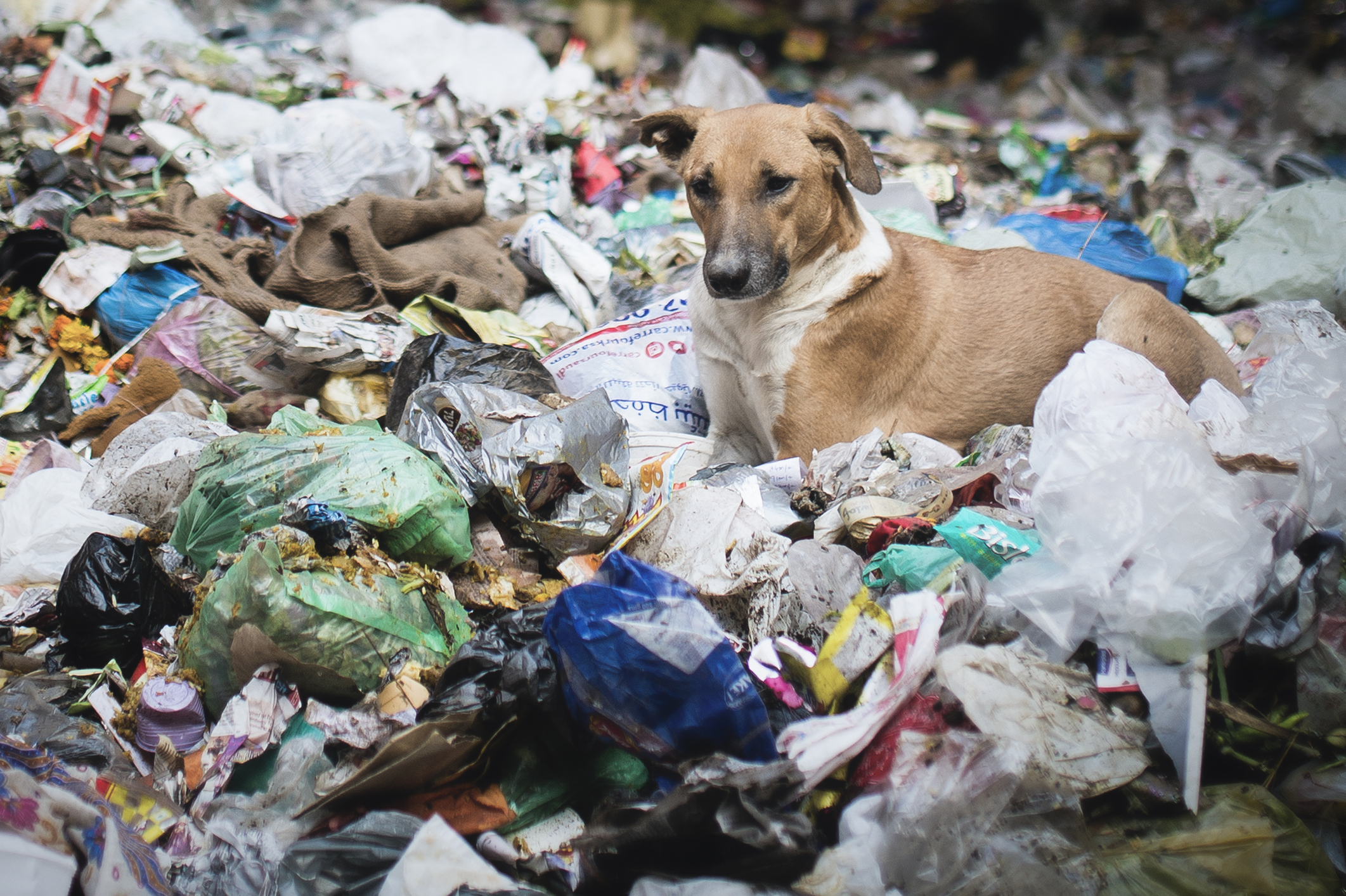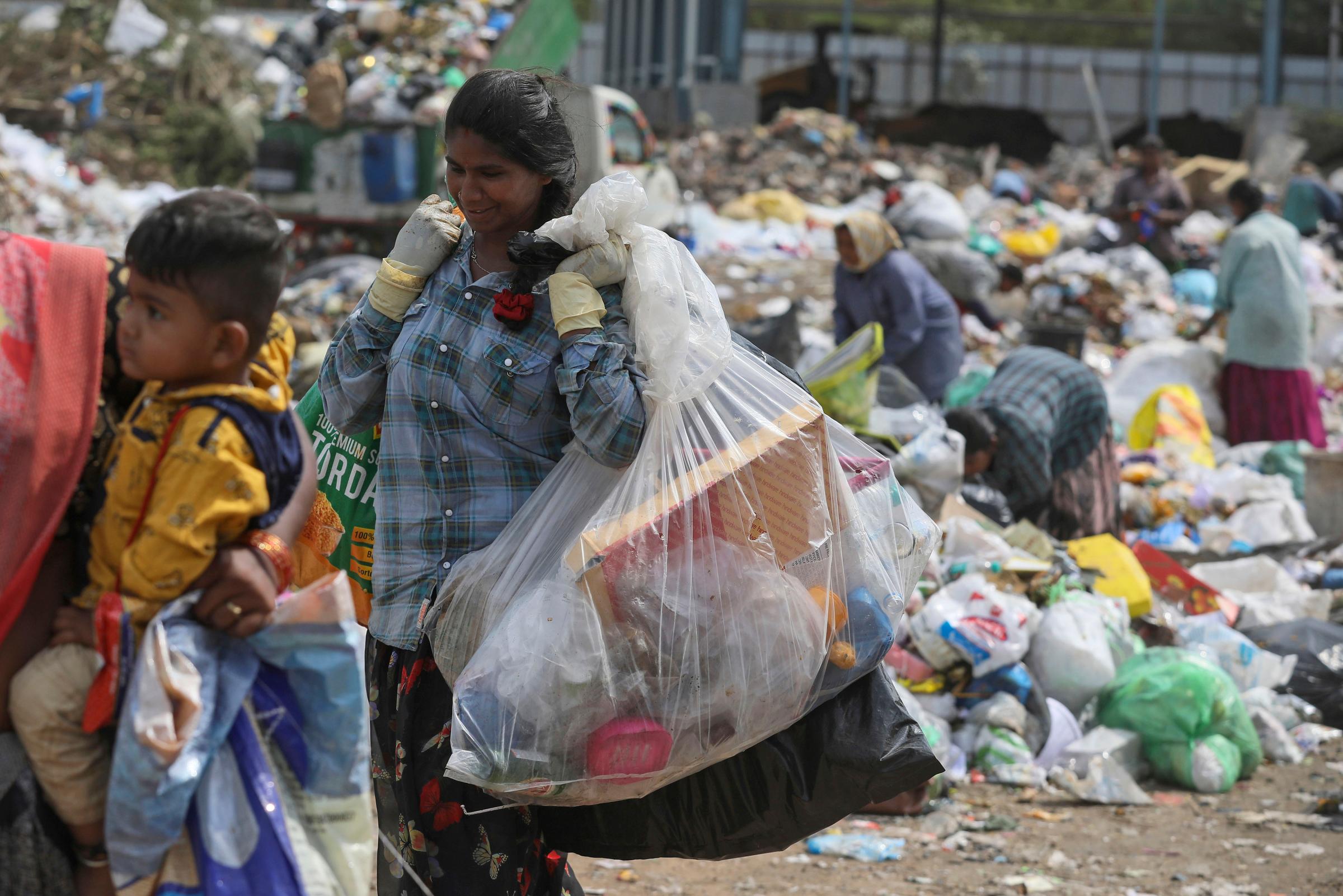
As dawn breaks out over New Delhi, 15-year-old Alamgir Munna picks up his thela (cart) and heads out for work, such that it is.
At an age when he should be in school, the young ragpicker sifts through heaps of garbage for scraps of salable plastic and metals at the Okhla landfill, one of the three giant dumping grounds in the sprawling Indian capital, which produces about 10,000 tons of garbage every day. Munna is among the estimated 150,000 ragpickers in Delhi who work at the country’s three trash mountains—one of which is as tall as the Taj Mahal. Not officially recognized as sanitation workers, they brave the methane and other deadly chemicals from the decomposing waste, wild dogs, disease and putrid stench, to recycle about a fifth of the city’s garbage.
Munna makes a pittance, about 500 rupees, or $7, a day for his back-breaking work. Even that sad apology for a livelihood is about to disappear as India is set to implement a ban starting July 1 on single-use plastics, which are used to make items like earbuds, lollipop sticks, polystyrene packets, plates, cups, spoons, packaging wraps, cigarette packs and stirrers, among the other items of daily use that populate our life. Manufacture, import, stocking, distribution, sale, and use of these items made of single-use plastics which have “low utility and high littering potential” will not be allowed anymore, according to the Ministry of Environment, Forest and Climate Change. Penalties include up to five years in jail, 100,000 rupees ($1,200) or both.

Like many other migrants who clean after the city’s leftovers, Munna is contemplating leaving Delhi and returning to his village. With the ban looming and no alternative livelihood in sight, he is bracing for an uncertain economic future—along with the rest of India’s 5 million ragpickers, equivalent to Ireland’s total population. For someone like him, with no skills or education and just about surviving on the margins of society—and the law—economic uncertainty is a euphemism for destitution, hunger, and worse.
The outlook is far less dire but no less alarming for the country’s 50,000 plastic manufacturing units—most of them small and medium-sized companies that, combined, employ about 400,000 people—as well as consumer conglomerates that depend on plastic for their wares. Leading beverage companies, for example, have been pleading with the government to put off the ban as they struggle to find replacements for the ubiquitous plastic straws accompanying their drink products.
As India finally takes the plunge in the war against plastic, the confusion, panic and uncertainty mirror the global struggle to transition away from plastic-dependence that is crucial to meet emission goals. It also underscores the urgency of breaking an addiction that is wrecking the planet and the heavy price nations have to pay for it.
Read more: U.S. Plastic Recycling Rates Are Even Worse Than We Thought
Few countries exemplify the double bind more than India. The Environmental Performance Index report for 2022 released on June 5 by Yale and Columbia universities ranks India (tied with Nigeria) as the least environmentally sustainable country out of a list of 180. India has rejected the findings of the report, but it accounts for a third of the 11 million tons of plastic waste flowing into the oceans every year, according to government figures. The country’s laws require all plastic waste to be separated and reused in projects like paving road and that only a small percentage of recyclables should be dumped in landfills. Mountains of garbage such as the one at Okhla speak otherwise. More than 40% of the total plastic waste in India is not even collected, let alone separated and recycled.
Some Indian states, such as Maharashtra and Karnataka have tried to ban single-use plastic in the past, but those efforts have largely been failures. That leave many skeptical about the new nationwide attempt. But Venkatesh Dutta, a professor at the School of Earth and Environmental Sciences in the Babasaheb Bhimrao Ambedkar University says that unlike the unsuccessful bans of plastic bags that have been tried earlier, this time the federal government is addressing the problem through the entire supply chain—starting from banning the manufacture and distribution of single-use plastic to banning its sale, possession, and imports.
If this national ban going into effect July 1 works, India will replace single-use plastic bags with thicker ones that are more durable, which in turn should help reduce overall plastic use. It will also move a step closer to eliminating multilayered plastic in future, the final frontier in the war on non-recyclables. The government has been toying with the idea of banning multilayered plastic, used in consumer-packaged goods of all manner, from ready-to-eat snacks to milk packets, but has been held back by the economic disruption such a move could unleash.
Read more: Reusable Packaging Is the Latest Eco-Friendly Trend. But Does It Actually Make a Difference?
That poses a problem for the lofty goals that the world has set for itself. In what the United Nations Environment Programme calls the most important environmental deal since the 2015 Paris Agreement, 175 countries, including India, signed a treaty this March at the UN Environment Assembly that pledged to end plastic pollution by formulating an internationally binding treaty by 2024.
But transitions such as these are daunting even for the most advanced of economies. Earlier this month, the U.S. announced a plan to phase out the sale of single-use plastic products in national parks and other public lands, but only by 2032. For a country such as India aiming for a more radical ban and much earlier, the challenges are even greater. But Prime Minister Narendra Modi’s government, which first announced the single-use plastic ban in 2016, has refused to budge in the face of the chorus of appeals from industry groups to postpone the ban.

Sunita Narain, director of the Center for Science and Environment in New Delhi, says pushing through the ban is one thing, but implementing it is a different matter altogether, given the limited resources of the country’s pollution board, lack of public awareness, and a proper plan to transition into recyclables.
“You can’t just dictate these things,” says Narain. “It has to be a priority for the government to support the small-scale industries in the transition process.” Companies recycling waste plastic into products such as tiles and furniture often struggle to compete in the market because of their high production costs. Environmentalists like Narain have been calling for government incentives to help such companies in the recycling business.
Recycling is the way to go, not fines and bans
Globally, Kenya’s 2017 ban on single-use plastic bags, which imposed one of the heaviest fines in the world for manufacturing or possessing plastic, is often hailed as one of the most successful steps toward eliminating plastic. But Leah Oyake-Ombis, director of the Africa Livelihood Innovations for Sustainable Environment Consulting Group at the University of Nairobi and a notable critic of the ban, advocates a different approach, which emphasizes recycling and waste management over fines or bans. Developing economies are more likely to benefit more from this strategy, thanks to the employment opportunities it can create within the recycling chain, Oyake-Ombis says.
Government subsidies would be key to creating jobs while transitioning. But right now the bigger problem is keeping jobs. Much of the loss will be felt in India’s vast informal economy, which employs more than 80% of its workers such as Munna. “What will we do when there are no plastics to sell?” Munna asks, perhaps looking for suggestions.
In the formal sector, while India’s consumer goods companies will in general suffer as a result of the ban, small companies will be hit disproportionately harder, says Ashok Kumar Agarwal, president of the Indian Industries Association. That’s because, unlike conglomerates, they won’t be able to absorb the coming losses. “The government should offer subsidies for new machines, and other incentives for the transition to alternatives,” he says.
As of now, there is no such assistance available, creating a supply crunch in recyclable replacements for the plastic needed to make consumer packaged goods. It also keeps plastic much cheaper than the alternatives available.

In 2016, the same year that the Indian government announced the plastic ban, Hemant Rohra left his full-time job and took a huge personal risk to start a small business making carry bags using a more biodegradable form of polypropylene—the basic element used to make plastic—by adding calcium and other minerals to it.
He had hoped that demand for biodegradable bags would increase with time. But it didn’t happen, as his bags cost six times more than regular plastic bags. He now wants lower taxes for his products. But more importantly, he says, the government should make sure that the ban is implemented properly.
In India, ambitious laws can often be applied lightly on the ground, allowing for loopholes. Similar expectations for this plastic ban is not misplaced given that industry groups have been urging the government to extend the deadline or go slow even days before the law is to kick in.
But the government is in no mood to bend. It is setting up control rooms and special enforcement teams across the country. State border checkpoints have been asked to look out for the banned items. As Environment, Forests and Climate Change Minister Bhupender Yadav, said on June 28, “We have given manufacturers plenty of time for preparation—11 months—before the ban was to come into force.”
More Must-Reads from TIME
- How Donald Trump Won
- The Best Inventions of 2024
- Why Sleep Is the Key to Living Longer
- Robert Zemeckis Just Wants to Move You
- How to Break 8 Toxic Communication Habits
- Nicola Coughlan Bet on Herself—And Won
- Why Vinegar Is So Good for You
- Meet TIME's Newest Class of Next Generation Leaders
Contact us at letters@time.com